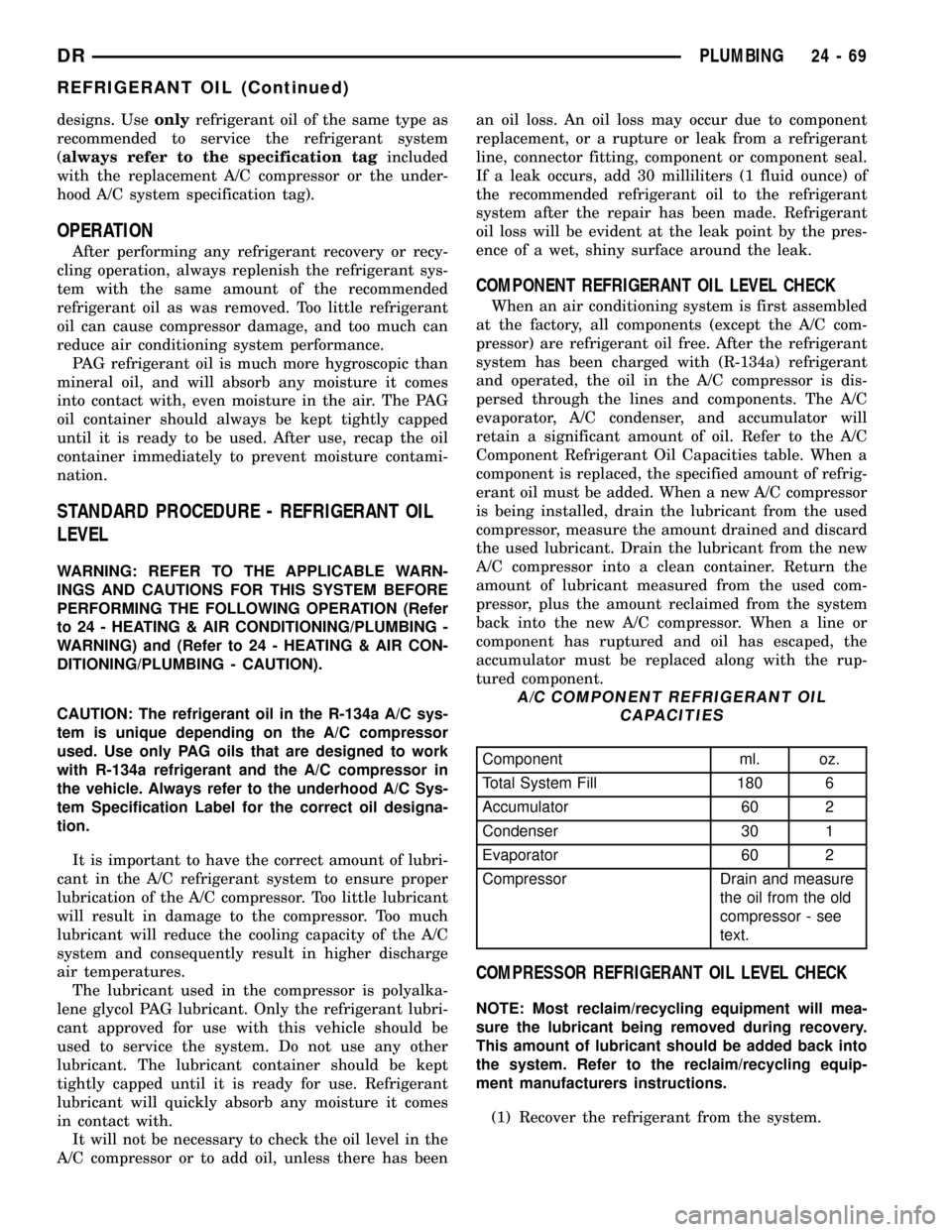Connector DODGE RAM 1500 1998 2.G Workshop Manual
[x] Cancel search | Manufacturer: DODGE, Model Year: 1998, Model line: RAM 1500, Model: DODGE RAM 1500 1998 2.GPages: 2627
Page 2546 of 2627

(11) Remove the tape or plugs from the discharge
line fitting and condenser inlet port.
(12) Lubricate a new rubber O-ring seal with clean
refrigerant oil and install it on the discharge line fit-
ting. Use only the specified O-ring as it is made of a
special material for the R-134a system. Use only
refrigerant oil of the type recommended for the A/C
compressor in the vehicle.
(13) Connect the discharge line to the condenser
inlet port.
(14) Install and tighten the nut that secures the
discharge line fitting to the condenser. Tighten the
nut to 20 N´m (180 in. lbs.).
(15) Connect the wire harness connector to the A/C
pressure transducer.
(16) Reconnect the battery negative cable.
(17) Evacuate the refrigerant system (Refer to 24 -
HEATING & AIR CONDITIONING/PLUMBING -
STANDARD PROCEDURE - REFRIGERANT SYS-
TEM EVACUATE).
(18) Charge the refrigerant system (Refer to 24 -
HEATING & AIR CONDITIONING/PLUMBING -
STANDARD PROCEDURE - REFRIGERANT SYS-
TEM CHARGE).
INSTALLATION - 3.7L/4.7L AND 5.7L HEMI
ENGINE
(1) If removed, install the A/C pressure transducer
onto the discharge line using a new O-ring seal.
Tighten the transducer securely.
(2) Position the discharge line into the engine com-
partment.
(3) Remove the tape or plugs from the discharge
line fitting and the compressor outlet port.
(4) Lubricate a new rubber O-ring seal with clean
refrigerant oil and install it on the discharge line fit-
ting. Use only the specified O-ring as it is made of a
special material for the R-134a system. Use only
refrigerant oil of the type recommended for the A/C
compressor in the vehicle.
(5) Connect the discharge line to the compressor.
(6) Install and tighten the nut that secures the
discharge line to the compressor. Tighten the nut to
28 N´m (20 ft. lbs.).
(7) Remove the tape or plugs from the discharge
line fitting and condenser inlet port.
(8) Lubricate a new rubber O-ring seal with clean
refrigerant oil and install it on the discharge line fit-
ting. Use only the specified O-ring as it is made of a
special material for the R-134a system. Use only
refrigerant oil of the type recommended for the A/C
compressor in the vehicle.(9) Connect the discharge line to the condenser
inlet port.
(10) Install and tighten the nut that secures the
discharge line fitting to the condenser. Tighten the
nut to 20 N´m (180 in. lbs.).
(11) Connect the wire harness connector to the A/C
pressure transducer.
(12) Reconnect the battery negative cable.
(13) Evacuate the refrigerant system (Refer to 24 -
HEATING & AIR CONDITIONING/PLUMBING -
STANDARD PROCEDURE - REFRIGERANT SYS-
TEM EVACUATE).
(14) Charge the refrigerant system (Refer to 24 -
HEATING & AIR CONDITIONING/PLUMBING -
STANDARD PROCEDURE - REFRIGERANT SYS-
TEM CHARGE).
A/C EVAPORATOR
DESCRIPTION
The A/C evaporator is located in the HVAC hous-
ing, behind the instrument panel. The evaporator is
positioned in the HVAC housing so that all air that
enters the housing must pass over the fins of the
evaporator coils before it is distributed through the
system ducts and outlets. However, air passing over
the evaporator fins will only be conditioned when the
compressor is engaged and circulating refrigerant
through the evaporator tubes.
OPERATION
Refrigerant enters the A/C evaporator from the
fixed orifice tube as a low-temperature, low-pressure
mixture of liquid and gas. As air flows over the fins
of the A/C evaporator, the humidity in the air con-
denses on the fins, and the heat from the air is
absorbed by the refrigerant. Heat absorption causes
the refrigerant to boil and vaporize. The refrigerant
becomes a low-pressure gas before it leaves the A/C
evaporator.
The A/C evaporator cannot be repaired and, if
faulty or damaged, it must be replaced.
DRPLUMBING 24 - 59
A/C DISCHARGE LINE (Continued)
Page 2551 of 2627

HEATER INLET HOSE
REMOVAL
The heater inlet hose is constructed from rubber
hoses and plastic hose connectors. The ends are
secured to the heater core, engine and engine coolant
reservoir (depending on engine application) by spring
tension clamps.
WARNING: REVIEW THE WARNINGS AND CAU-
TIONS IN THE FRONT OF THIS SECTION BEFORE
PERFORMING THE FOLLOWING OPERATION (Refer
to 24 - HEATING & AIR CONDITIONING/PLUMBING -
WARNING) and (Refer to 24 - HEATING & AIR CON-
DITIONING/PLUMBING - CAUTION).
(1) Drain the engine cooling system (Refer to 7 -
COOLING - STANDARD PROCEDURE - COOLING
SYSTEM DRAIN).
(2) Remove the heater hose retaining brackets as
required (depending on engine application).
(3) Using spring tension clamp pliers, compress
and slide the clamps off of each end of the hose being
removed (Fig. 24).
CAUTION: DO NOT apply excessive pressure on
heater tubes or connections when removing heater
hoses. Excessive pressure may damage or deform
the tubes/heater core, causing an engine coolant
leak.
(4) Disconnect each hose end by carefully twisting
the hose back and forth on the tube, while gently
pulling it away from the end of the tube.
(5) If necessary, carefully cut the hose end and
peel the hose off of the tube.
NOTE: Replacement of the heater inlet hose will be
required if the hose ends are cut for removal.
(6) Remove the heater inlet hose from the engine
compartment.
(7) Separate the heater hoses from each other as
required (depending on engine application).
INSTALLATION
(1) If separated, reconnect the heater hoses to each
other as required (depending on engine application).
(2) Position the heater inlet hose into the engine
compartment.
(3) Using spring tension clamp pliers, compress
and slide each clamp away from the end of the hose
being installed.
(4) Install each hose by carefully twisting the hose
back and forth while gently pushing it onto the tube
end.(5) Using spring tension clamp pliers, compress
and slide the clamps onto each end of the hose being
installed.
(6) Install the heater hose retaining brackets as
required (depending on engine application).
(7) Refill the engine cooling system (Refer to 7 -
COOLING - STANDARD PROCEDURE - COOLING
SYSTEM REFILL).
HEATER RETURN HOSE
REMOVAL
The heater return hose is constructed from rubber
hoses and plastic hose connectors. The ends are
secured to the heater core, engine and engine coolant
reservoir (depending on engine application) by spring
tension clamps.
WARNING: REVIEW THE WARNINGS AND CAU-
TIONS IN THE FRONT OF THIS SECTION BEFORE
PERFORMING THE FOLLOWING OPERATION (Refer
to 24 - HEATING & AIR CONDITIONING/PLUMBING -
WARNING) and (Refer to 24 - HEATING & AIR CON-
DITIONING/PLUMBING - CAUTION).
Fig. 24 Heater Hoses - Typical
1 - HEATER CORE TUBES
2 - HEATER INLET HOSE
3 - RETAINING BRACKET
4 - HOSE CONNECTOR
5 - SPRING CLAMP
6 - HEATER RETURN HOSE
24 - 64 PLUMBINGDR
Page 2552 of 2627

(1) Drain the engine cooling system (Refer to 7 -
COOLING - STANDARD PROCEDURE - COOLING
SYSTEM DRAIN).
(2) Remove the heater hose retaining brackets as
required (depending on engine application).
(3) Using spring tension clamp pliers, compress
and slide the clamps off of each end of the hose being
removed (Fig. 25).
CAUTION: DO NOT apply excessive pressure on
heater tubes or connections when removing heater
hoses. Excessive pressure may damage or deform
the tubes/heater core, causing an engine coolant
leak.
(4) Disconnect each hose end by carefully twisting
the hose back and forth on the tube, while gently
pulling it away from the end of the tube.
(5) If necessary, carefully cut the hose end and
peel the hose off of the tube.
NOTE: Replacement of the heater return hose will
be required if the hose ends are cut for removal.
(6) Remove the heater return hose from the engine
compartment.
(7) Separate the heater hoses from each other as
required (depending on engine application).INSTALLATION
(1) If separated, reconnect the heater hoses to each
other as required (depending on engine application).
(2) Position the heater return hose into the engine
compartment.
(3) Using spring tension clamp pliers, compress
and slide each clamp away from the end of the hose
being installed.
(4) Install each hose by carefully twisting the hose
back and forth while gently pushing it onto the tube
end.
(5) Using spring tension clamp pliers, compress
and slide the clamps onto each end of the hose being
installed.
(6) Install the heater hose retaining brackets as
required (depending on engine application).
(7) Refill the engine cooling system (Refer to 7 -
COOLING - STANDARD PROCEDURE).
LIQUID LINE
DESCRIPTION
The liquid line is the refrigerant line that carries
refrigerant from the A/C condenser to the evaporator.
The liquid line for this model consist of two separate
lines that connect to each other. The liquid lines are
made from light-weight aluminum or steel, and use
braze-less fittings.
The front half of the liquid line contains the fixed
orifice tube. The liquid lines are only serviced as an
assembly, except for the rubber O-ring seals used on
the end fittings. The liquid lines cannot be adjusted
or repaired and, if found to be leaking or damaged,
they must be replaced.
REMOVAL
WARNING: REVIEW THE WARNINGS AND CAU-
TIONS IN THE FRONT OF THIS SECTION BEFORE
PERFORMING THE FOLLOWING OPERATION (Refer
to 24 - HEATING & AIR CONDITIONING/PLUMBING -
WARNING) and (Refer to 24 - HEATING & AIR CON-
DITIONING/PLUMBING - CAUTION).
(1) Disconnect and isolate the battery negative
cable.
(2) If equipped with the diesel engine, remove the
passenger side battery (Refer to 8 - ELECTRICAL/
BATTERY SYSTEM/BATTERY - REMOVAL).
(3) If equipped with the diesel engine, remove the
passenger side battery tray (Refer to 8 - ELECTRI-
CAL/BATTERY SYSTEM/TRAY - REMOVAL).
(4) Recover the refrigerant from the refrigerant
system (Refer to 24 - HEATING & AIR CONDITION-
Fig. 25 Heater Hoses - Typical
1 - HEATER CORE TUBES
2 - HEATER INLET HOSE
3 - RETAINING BRACKET
4 - HOSE CONNECTOR
5 - SPRING CLAMP
6 - HEATER RETURN HOSE
DRPLUMBING 24 - 65
HEATER RETURN HOSE (Continued)
Page 2556 of 2627

designs. Useonlyrefrigerant oil of the same type as
recommended to service the refrigerant system
(always refer to the specification tagincluded
with the replacement A/C compressor or the under-
hood A/C system specification tag).
OPERATION
After performing any refrigerant recovery or recy-
cling operation, always replenish the refrigerant sys-
tem with the same amount of the recommended
refrigerant oil as was removed. Too little refrigerant
oil can cause compressor damage, and too much can
reduce air conditioning system performance.
PAG refrigerant oil is much more hygroscopic than
mineral oil, and will absorb any moisture it comes
into contact with, even moisture in the air. The PAG
oil container should always be kept tightly capped
until it is ready to be used. After use, recap the oil
container immediately to prevent moisture contami-
nation.
STANDARD PROCEDURE - REFRIGERANT OIL
LEVEL
WARNING: REFER TO THE APPLICABLE WARN-
INGS AND CAUTIONS FOR THIS SYSTEM BEFORE
PERFORMING THE FOLLOWING OPERATION (Refer
to 24 - HEATING & AIR CONDITIONING/PLUMBING -
WARNING) and (Refer to 24 - HEATING & AIR CON-
DITIONING/PLUMBING - CAUTION).
CAUTION: The refrigerant oil in the R-134a A/C sys-
tem is unique depending on the A/C compressor
used. Use only PAG oils that are designed to work
with R-134a refrigerant and the A/C compressor in
the vehicle. Always refer to the underhood A/C Sys-
tem Specification Label for the correct oil designa-
tion.
It is important to have the correct amount of lubri-
cant in the A/C refrigerant system to ensure proper
lubrication of the A/C compressor. Too little lubricant
will result in damage to the compressor. Too much
lubricant will reduce the cooling capacity of the A/C
system and consequently result in higher discharge
air temperatures.
The lubricant used in the compressor is polyalka-
lene glycol PAG lubricant. Only the refrigerant lubri-
cant approved for use with this vehicle should be
used to service the system. Do not use any other
lubricant. The lubricant container should be kept
tightly capped until it is ready for use. Refrigerant
lubricant will quickly absorb any moisture it comes
in contact with.
It will not be necessary to check the oil level in the
A/C compressor or to add oil, unless there has beenan oil loss. An oil loss may occur due to component
replacement, or a rupture or leak from a refrigerant
line, connector fitting, component or component seal.
If a leak occurs, add 30 milliliters (1 fluid ounce) of
the recommended refrigerant oil to the refrigerant
system after the repair has been made. Refrigerant
oil loss will be evident at the leak point by the pres-
ence of a wet, shiny surface around the leak.
COMPONENT REFRIGERANT OIL LEVEL CHECK
When an air conditioning system is first assembled
at the factory, all components (except the A/C com-
pressor) are refrigerant oil free. After the refrigerant
system has been charged with (R-134a) refrigerant
and operated, the oil in the A/C compressor is dis-
persed through the lines and components. The A/C
evaporator, A/C condenser, and accumulator will
retain a significant amount of oil. Refer to the A/C
Component Refrigerant Oil Capacities table. When a
component is replaced, the specified amount of refrig-
erant oil must be added. When a new A/C compressor
is being installed, drain the lubricant from the used
compressor, measure the amount drained and discard
the used lubricant. Drain the lubricant from the new
A/C compressor into a clean container. Return the
amount of lubricant measured from the used com-
pressor, plus the amount reclaimed from the system
back into the new A/C compressor. When a line or
component has ruptured and oil has escaped, the
accumulator must be replaced along with the rup-
tured component.
A/C COMPONENT REFRIGERANT OIL
CAPACITIES
Component ml. oz.
Total System Fill 180 6
Accumulator 60 2
Condenser 30 1
Evaporator 60 2
Compressor Drain and measure
the oil from the old
compressor - see
text.
COMPRESSOR REFRIGERANT OIL LEVEL CHECK
NOTE: Most reclaim/recycling equipment will mea-
sure the lubricant being removed during recovery.
This amount of lubricant should be added back into
the system. Refer to the reclaim/recycling equip-
ment manufacturers instructions.
(1) Recover the refrigerant from the system.
DRPLUMBING 24 - 69
REFRIGERANT OIL (Continued)
Page 2558 of 2627

(1) Disconnect and isolate the battery negative
cable.
(2) Recover the refrigerant from the refrigerant
system (Refer to 24 - HEATING & AIR CONDITION-
ING/PLUMBING - STANDARD PROCEDURE -
REFRIGERANT RECOVERY).
(3) Disconnect the wire harness connector from the
A/C pressure transducer.
(4) Remove the nut that secures the discharge line
fitting to the condenser inlet port (Fig. 29).
(5) Disconnect the discharge line from the con-
denser.
(6) Remove the O-ring seal from the discharge line
fitting and discard.
(7) Install plugs in, or tape over the discharge line
fitting and condenser inlet port.
(8) Remove the bolt that secures the suction/dis-
charge line assembly to the A/C compressor.
(9) Disconnect the suction/discharge line assembly
from the A/C compressor.
(10) Remove the O-ring seals from the suction and
discharge line fittings and discard.
(11) Install plugs in, or tape over all of the opened
refrigerant line fittings and the compressor ports.(12) Remove the secondary retaining clip from the
spring-lock coupler that secures the suction line to
the accumulator outlet tube (Fig. 30).
(13) Using the proper A/C line disconnect tool, dis-
connect the suction line from the accumulator outlet
tube (Refer to 24 - HEATING & AIR CONDITION-
ING/PLUMBING/REFRIGERANT LINE COUPLER -
REMOVAL).
(14) Remove the O-ring seal from the accumulator
outlet tube fitting and discard.
(15) Install plugs in, or tape over the opened suc-
tion line and the accumulator outlet tube fitting.
(16) Remove the suction/discharge line assembly
from the engine compartment.
(17) If necessary, remove the A/C pressure trans-
ducer from the discharge line.
REMOVAL - 3.7L/4.7L AND 5.7L HEMI ENGINE
WARNING: REVIEW THE WARNINGS AND CAU-
TIONS IN THE FRONT OF THIS SECTION BEFORE
PERFORMING THE FOLLOWING OPERATION (Refer
to 24 - HEATING & AIR CONDITIONING/PLUMBING -
WARNING) and (Refer to 24 - HEATING & AIR CON-
DITIONING/PLUMBING - CAUTION).
Fig. 29 A/C Suction Line - 5.9L Diesel Engine
1 - CONDENSER
2 - NUT
3 - LIQUID LINE
4 - NUT
5 - PRESSURE TRANSDUCER WIRE CONNECTOR
6 - A/C COMPRESSOR
7 - BOLT
8 - SUCTION/DISCHARGE LINE ASSEMBLY
Fig. 30 Suction Line - A/C Accumulator
1 - RH INNER FENDER
2 - ACCUMULATOR INLET TUBE
3 - A/C LINE SECONDARY RETAINING CLIP
4 - EVAPORATOR OUTLET TUBE
5 - BOLTS (2)
6 - ACCUMULATOR
7 - SUCTION LINE
8 - A/C LOW PRESSURE SERVICE PORT
9 - A/C LINE SECONDARY RETAINING CLIP
DRPLUMBING 24 - 71
SUCTION LINE (Continued)
Page 2559 of 2627

(1) Disconnect and isolate the battery negative
cable.
(2) Recover the refrigerant from the refrigerant
system (Refer to 24 - HEATING & AIR CONDITION-
ING/PLUMBING - STANDARD PROCEDURE -
REFRIGERANT RECOVERY).
(3) Remove the nut that secures the suction line
fitting to the compressor inlet port (Fig. 31) or (Fig.
32), depending on application.
(4) Disconnect the suction line from the compres-
sor.
(5) Remove the O-ring seal from the suction line
fitting and discard.
(6) Install plugs in, or tape over the suction line
fitting and compressor inlet port.
(7) Remove the secondary retaining clip from the
spring-lock coupler that secures the suction line to
the accumulator outlet tube (Fig. 33).
(8) Using the proper A/C line disconnect tool, dis-
connect the suction line from the accumulator outlet
tube (Refer to 24 - HEATING & AIR CONDITION-
ING/PLUMBING/REFRIGERANT LINE COUPLER -
REMOVAL).
(9) Remove the O-ring seal from the accumulator
outlet tube fitting and discard.(10) Install plugs in, or tape over the opened suc-
tion line and the accumulator outlet tube fitting.
INSTALLATION
INSTALLATION - 5.9L DIESEL ENGINE
(1) If removed, install the A/C pressure transducer
onto the discharge line using a new O-ring seal.
Tighten the transducer securely.
(2) Position the suction/discharge line assembly
into the engine compartment.
(3) Remove the tape or plugs from the suction line
and the accumulator outlet tube fitting.
(4) Lubricate a new rubber O-ring seal with clean
refrigerant oil and install it on the accumulator out-
let tube fitting. Use only the specified O-ring as it is
made of a special material for the R-134a system.
Use only refrigerant oil of the type recommended for
the A/C compressor in the vehicle.
(5) Connect the suction line to the accumulator
outlet tube (Refer to 24 - HEATING & AIR CONDI-
TIONING/PLUMBING/REFRIGERANT LINE COU-
PLER - INSTALLATION).
(6) Install the secondary retaining clip onto the
spring-lock coupler that secures the suction line to
the accumulator outlet tube.Fig. 31 A/C Discharge Line - 3.7L Shown, 4.7L
Typical
1 - NUT
2 - FRONT UPPER CROSSMEMBER
3 - A/C CONDENSER
4 - NUT (2)
5 - SUCTION LINE
6 - A/C COMPRESSOR
7 - A/C PRESSURE TRANSDUCER
8 - WIRE HARNESS CONNECTOR
9 - A/C DISCHARGE LINE
Fig. 32 A/C Suction Line - 5.7L Hemi Engine
1 - DISCHARGE LINE
2 - NUT
3 - CONDENSER
4 - NUT
5 - SUCTION LINE
6 - A/C COMPRESSOR
7 - NUT
8 - A/C PRESSURE TRANSDUCER
24 - 72 PLUMBINGDR
SUCTION LINE (Continued)
Page 2560 of 2627

(7) Remove the tape or plugs from the suction and
discharge line fittings and the compressor ports.
(8) Lubricate new rubber O-ring seals with clean
refrigerant oil and install them on the suction and
discharge line fittings. Use only the specified O-rings
as they are made of a special material for the R-134a
system. Use only refrigerant oil of the type recom-
mended for the A/C compressor in the vehicle.
(9) Connect the suction/discharge line assembly to
the compressor.
(10) Install and tighten the bolt that secures the
suction/discharge line assembly to the compressor.
Tighten the bolt to 28 N´m (20 ft. lbs.).
(11) Remove the tape or plugs from the discharge
line fitting and condenser inlet port.
(12) Lubricate a new rubber O-ring seal with clean
refrigerant oil and install it on the discharge line fit-
ting. Use only the specified O-ring as it is made of a
special material for the R-134a system. Use only
refrigerant oil of the type recommended for the A/C
compressor in the vehicle.
(13) Connect the discharge line to the condenser
inlet port.(14) Install and tighten the nut that secures the
discharge line fitting to the condenser. Tighten the
nut to 20 N´m (180 in. lbs.).
(15) Connect the wire harness connector to the A/C
pressure transducer.
(16) Reconnect the battery negative cable.
(17) Evacuate the refrigerant system (Refer to 24 -
HEATING & AIR CONDITIONING/PLUMBING -
STANDARD PROCEDURE - REFRIGERANT SYS-
TEM EVACUATE).
(18) Charge the refrigerant system (Refer to 24 -
HEATING & AIR CONDITIONING/PLUMBING -
STANDARD PROCEDURE - REFRIGERANT SYS-
TEM CHARGE).
INSTALLATION - 3.7L/4.7L AND 5.7L HEMI
ENGINE
(1) Position the suction line into the engine com-
partment.
(2) Remove the tape or plugs from the suction line
fitting and the compressor inlet port.
(3) Lubricate a new rubber O-ring seal with clean
refrigerant oil and install it on the suction line fit-
ting. Use only the specified O-ring as it is made of a
special material for the R-134a system. Use only
refrigerant oil of the type recommended for the A/C
compressor in the vehicle.
(4) Connect the suction line to the compressor.
(5) Install and tighten the nut that secures the
suction line to the compressor. Tighten the nut to 28
N´m (20 ft. lbs.).
(6) Remove the tape or plugs from the suction line
and the accumulator outlet tube fitting.
(7) Lubricate a new rubber O-ring seal with clean
refrigerant oil and install it on the accumulator out-
let tube fitting. Use only the specified O-ring as it is
made of a special material for the R-134a system.
Use only refrigerant oil of the type recommended for
the A/C compressor in the vehicle.
(8) Connect the suction line to the accumulator
outlet tube (Refer to 24 - HEATING & AIR CONDI-
TIONING/PLUMBING/REFRIGERANT LINE COU-
PLER - INSTALLATION).
(9) Install the secondary retaining clip onto the
spring-lock coupler that secures the suction line to
the accumulator outlet tube.
(10) Reconnect the battery negative cable.
(11) Evacuate the refrigerant system (Refer to 24 -
HEATING & AIR CONDITIONING/PLUMBING -
STANDARD PROCEDURE - REFRIGERANT SYS-
TEM EVACUATE).
(12) Charge the refrigerant system (Refer to 24 -
HEATING & AIR CONDITIONING/PLUMBING -
STANDARD PROCEDURE - REFRIGERANT SYS-
TEM CHARGE).
Fig. 33 A/C Accumulator - Typical
1 - RH INNER FENDER
2 - ACCUMULATOR INLET TUBE
3 - A/C LINE SECONDARY RETAINING CLIP
4 - EVAPORATOR OUTLET TUBE
5 - BOLTS (2)
6 - ACCUMULATOR
7 - SUCTION LINE
8 - A/C LOW PRESSURE SERVICE PORT
9 - A/C LINE SECONDARY RETAINING CLIP
DRPLUMBING 24 - 73
SUCTION LINE (Continued)
Page 2562 of 2627

EMISSIONS CONTROL
TABLE OF CONTENTS
page page
EMISSIONS CONTROL
DESCRIPTION
DESCRIPTION - STATE DISPLAY TEST
MODE...............................1
DESCRIPTION - CIRCUIT ACTUATION TEST
MODE...............................1
DESCRIPTION - DIAGNOSTIC TROUBLE
CODES..............................1
DESCRIPTION - TASK MANAGER..........1DESCRIPTION - MONITORED SYSTEMS....2
DESCRIPTION - TRIP DEFINITION.........4
DESCRIPTION - COMPONENT MONITORS . . 4
OPERATION
OPERATION..........................5
OPERATION - TASK MANAGER...........5
OPERATION - NON-MONITORED CIRCUITS . . 8
EVAPORATIVE EMISSIONS................10
EMISSIONS CONTROL
DESCRIPTION
DESCRIPTION - STATE DISPLAY TEST MODE
The switch inputs to the Powertrain Control Mod-
ule (PCM) have two recognized states; HIGH and
LOW. For this reason, the PCM cannot recognize the
difference between a selected switch position versus
an open circuit, a short circuit, or a defective switch.
If the State Display screen shows the change from
HIGH to LOW or LOW to HIGH, assume the entire
switch circuit to the PCM functions properly. Connect
the DRB scan tool to the data link connector and
access the state display screen. Then access either
State Display Inputs and Outputs or State Display
Sensors.
DESCRIPTION - CIRCUIT ACTUATION TEST
MODE
The Circuit Actuation Test Mode checks for proper
operation of output circuits or devices the Powertrain
Control Module (PCM) may not internally recognize.
The PCM attempts to activate these outputs and
allow an observer to verify proper operation. Most of
the tests provide an audible or visual indication of
device operation (click of relay contacts, fuel spray,
etc.). Except for intermittent conditions, if a device
functions properly during testing, assume the device,
its associated wiring, and driver circuit work cor-
rectly. Connect the DRB scan tool to the data link
connector and access the Actuators screen.
DESCRIPTION - DIAGNOSTIC TROUBLE CODES
A Diagnostic Trouble Code (DTC) indicates the
PCM has recognized an abnormal condition in the
system.Remember that DTC's are the results of a sys-
tem or circuit failure, but do not directly iden-
tify the failed component or components.
BULB CHECK
Each time the ignition key is turned to the ON
position, the malfunction indicator (check engine)
lamp on the instrument panel should illuminate for
approximately 2 seconds then go out. This is done for
a bulb check.
OBTAINING DTC'S USING DRB SCAN TOOL
(1) Obtain the applicable Powertrain Diagnostic
Manual.
(2) Obtain the DRB Scan Tool.
(3) Connect the DRB Scan Tool to the data link
(diagnostic) connector. This connector is located in
the passenger compartment; at the lower edge of
instrument panel; near the steering column.
(4) Turn the ignition switch on and access the
ªRead Faultº screen.
(5) Record all the DTC's and ªfreeze frameº infor-
mation shown on the DRB scan tool.
(6) To erase DTC's, use the ªErase Trouble Codeº
data screen on the DRB scan tool.Do not erase any
DTC's until problems have been investigated
and repairs have been performed.
DESCRIPTION - TASK MANAGER
The PCM is responsible for efficiently coordinating
the operation of all the emissions-related compo-
nents. The PCM is also responsible for determining if
the diagnostic systems are operating properly. The
software designed to carry out these responsibilities
is call the 'Task Manager'.
DREMISSIONS CONTROL 25 - 1
Page 2566 of 2627

OPERATION
OPERATION
The Powertrain Control Module (PCM) monitors
many different circuits in the fuel injection, ignition,
emission and engine systems. If the PCM senses a
problem with a monitored circuit often enough to
indicate an actual problem, it stores a Diagnostic
Trouble Code (DTC) in the PCM's memory. If the
problem is repaired or ceases to exist, the PCM can-
cels the code after 40 warm-up cycles. Diagnostic
trouble codes that affect vehicle emissions illuminate
the Malfunction Indicator Lamp (MIL). The MIL is
displayed as an engine icon (graphic) on the instru-
ment panel. Refer to Malfunction Indicator Lamp in
this section.
Certain criteria must be met before the PCM
stores a DTC in memory. The criteria may be a spe-
cific range of engine RPM, engine temperature,
and/or input voltage to the PCM.
The PCM might not store a DTC for a monitored
circuit even though a malfunction has occurred. This
may happen because one of the DTC criteria for the
circuit has not been met.For example,assume the
diagnostic trouble code criteria requires the PCM to
monitor the circuit only when the engine operates
between 750 and 2000 RPM. Suppose the sensor's
output circuit shorts to ground when engine operates
above 2400 RPM (resulting in 0 volt input to the
PCM). Because the condition happens at an engine
speed above the maximum threshold (2000 rpm), the
PCM will not store a DTC.
There are several operating conditions for which
the PCM monitors and sets DTC's. Refer to Moni-
tored Systems, Components, and Non-Monitored Cir-
cuits in this section.
Technicians must retrieve stored DTC's by connect-
ing the DRB scan tool (or an equivalent scan tool) to
the 16±way data link connector. The connector is
located on the bottom edge of the instrument panel
near the steering column (Fig. 1).
NOTE: Various diagnostic procedures may actually
cause a diagnostic monitor to set a DTC. For
instance, pulling a spark plug wire to perform a
spark test may set the misfire code. When a repair
is completed and verified, connect the DRB scan
tool to the 16±way data link connector to erase all
DTC's and extinguish the MIL.
OPERATION - TASK MANAGER
The Task Manager determines which tests happen
when and which functions occur when. Many of the
diagnostic steps required by OBD II must be per-
formed under specific operating conditions. The TaskManager software organizes and prioritizes the diag-
nostic procedures. The job of the Task Manager is to
determine if conditions are appropriate for tests to be
run, monitor the parameters for a trip for each test,
and record the results of the test. Following are the
responsibilities of the Task Manager software:
²Test Sequence
²MIL Illumination
²Diagnostic Trouble Codes (DTCs)
²Trip Indicator
²Freeze Frame Data Storage
²Similar Conditions Window
Test Sequence
In many instances, emissions systems must fail
diagnostic tests more than once before the PCM illu-
minates the MIL. These tests are know as 'two trip
monitors.' Other tests that turn the MIL lamp on
after a single failure are known as 'one trip moni-
tors.' A trip is defined as 'start the vehicle and oper-
ate it to meet the criteria necessary to run the given
monitor.'
Many of the diagnostic tests must be performed
under certain operating conditions. However, there
are times when tests cannot be run because another
test is in progress (conflict), another test has failed
(pending) or the Task Manager has set a fault that
may cause a failure of the test (suspend).
²Pending
Under some situations the Task Manager will not
run a monitor if the MIL is illuminated and a fault is
stored from another monitor. In these situations, the
Task Manager postpones monitorspendingresolu-
tion of the original fault. The Task Manager does not
run the test until the problem is remedied.
Fig. 1 DATA LINK CONNECTOR LOCATION - TYPICAL
1 - 16-WAY DATA LINK CONNECTOR
DREMISSIONS CONTROL 25 - 5
EMISSIONS CONTROL (Continued)
Page 2570 of 2627

EXCESSIVE OIL CONSUMPTION
Although the PCM monitors engine exhaust oxygen
content when the system is in closed loop, it cannot
determine excessive oil consumption.
THROTTLE BODY AIR FLOW
The PCM cannot detect a clogged or restricted air
cleaner inlet or filter element.
VACUUM ASSIST
The PCM cannot detect leaks or restrictions in the
vacuum circuits of vacuum assisted engine control
system devices. However, these could cause the PCM
to store a MAP sensor diagnostic trouble code and
cause a high idle condition.PCM SYSTEM GROUND
The PCM cannot determine a poor system ground.
However, one or more diagnostic trouble codes may
be generated as a result of this condition. The mod-
ule should be mounted to the body at all times, also
during diagnostic.
PCM CONNECTOR ENGAGEMENT
The PCM may not be able to determine spread or
damaged connector pins. However, it might store
diagnostic trouble codes as a result of spread connec-
tor pins.
DREMISSIONS CONTROL 25 - 9
EMISSIONS CONTROL (Continued)